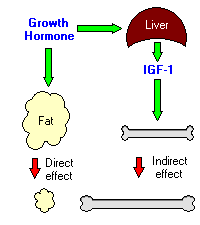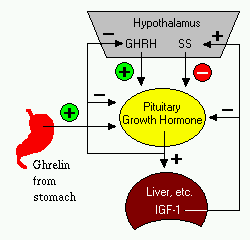VIVO Pathophysiology
Growth Hormone (Somatotropin)
Growth hormone is a protein hormone of about 190 amino acids that is synthesized and secreted by cells called somatotrophs in the anterior pituitary. It is a major participant in control of several complex physiologic processes, including growth and metabolism. Growth hormone is also of considerable interest as a drug used in both humans and animals.
Physiologic Effects of Growth Hormone
A critical concept in understanding growth hormone activity is that it has two distinct types of effects:

- Direct effects are the result of growth hormone binding its receptor on target cells. Fat cells (adipocytes), for example, have growth hormone receptors, and growth hormone stimulates them to break down triglyceride and supresses their ability to take up and accumulate circulating lipids.
- Indirect effects are mediated primarily by a insulin-like growth factor-I (IGF-I), a hormone that is secreted from the liver and other tissues in response to growth hormone. A majority of the growth promoting effects of growth hormone is actually due to IGF-I acting on its target cells.
Keeping this distinction in mind, we can discuss two major roles of growth hormone and its minion IGF-I in physiology.
Effects on GrowthGrowth is a very complex process, and requires the coordinated action of several hormones. The major role of growth hormone in stimulating body growth is to stimulate the liver and other tissues to secrete IGF-I. IGF-I stimulates proliferation of chondrocytes (cartilage cells), resulting in bone growth. Growth hormone does seem to have a direct effect on bone growth in stimulating differentiation of chondrocytes.
IGF-I also appears to be the key player in muscle growth. It stimulates both the differentiation and proliferation of myoblasts. It also stimulates amino acid uptake and protein synthesis in muscle and other tissues.
Metabolic EffectsGrowth hormone has important effects on protein, lipid and carbohydrate metabolism. In some cases, a direct effect of growth hormone has been clearly demonstrated, in others, IGF-I is thought to be the critical mediator, and some cases it appears that both direct and indirect effects are at play.
- Protein metabolism: In general, growth hormone stimulates protein anabolism in many tissues. This effect reflects increased amino acid uptake, increased protein synthesis and decreased oxidation of proteins.
- Fat metabolism: Growth hormone enhances the utilization of fat by stimulating triglyceride breakdown and oxidation in adipocytes.
- Carbohydrate metabolism: Growth hormone is one of a battery of hormones that serves to maintain blood glucose within a normal range. Growth hormone is often said to have anti-insulin activity, because it supresses the abilities of insulin to stimulate uptake of glucose in peripheral tissues and enhance glucose synthesis in the liver. Somewhat paradoxically, administration of growth hormone stimulates insulin secretion, leading to hyperinsulinemia.
Control of Growth Hormone Secretion
Production of growth hormone is modulated by many factors, including stress, exercise, nutrition, sleep and growth hormone itself. However, its primary controllers are two hypothalamic hormones and one hormone from the stomach:

- Growth hormone-releasing hormone (GHRH) is a hypothalamic peptide that stimulates both the synthesis and secretion of growth hormone.
- Somatostatin (SS) is a peptide produced by several tissues in the body, including the hypothalamus. Somatostatin inhibits growth hormone release in response to GHRH and to other stimulatory factors such as low blood glucose concentration.
- Ghrelin is a peptide hormone secreted from the stomach. Ghrelin binds to receptors on somatotrophs and potently stimulates secretion of growth hormone.
Growth hormone secretion is also part of a negative feedback loop involving IGF-I. High blood levels of IGF-I lead to decreased secretion of growth hormone not only by directly suppressing the somatotroph, but by stimulating release of somatostatin from the hypothalamus.
Growth hormone also feeds back to inhibit GHRH secretion and probably has a direct (autocrine) inhibitory effect on secretion from the somatotroph.
Integration of all the factors that affect growth hormone synthesis and secretion lead to a pulsatile pattern of release. Basal concentrations of growth hormone in blood are very low. In children and young adults, the most intense period of growth hormone release is shortly after the onset of deep sleep.
Disease States
States of both growth hormone deficiency and excess provide very visible testaments to the role of this hormone in normal physiology. Such disorders can reflect lesions in either the hypothalamus, the pituitary or in target cells. A deficiency state can result not only from a deficiency in production of the hormone, but in the target cell's response to the hormone.
Clinically, deficiency in growth hormone or defects in its binding to receptor are seen as growth retardation or dwarfism. The manifestation of growth hormone deficiency depends upon the age of onset of the disorder and can result from either heritable or acquired disease.
The effect of excessive secretion of growth hormone is also very dependent on the age of onset and is seen as two distinctive disorders:
- Giantism is the result of excessive growth hormone secretion that begins in young children or adolescents. It is a very rare disorder, usually resulting from a tumor of somatotropes. One of the most famous giants was a man named Robert Wadlow. He weighed 8.5 pounds at birth, but by 5 years of age was 105 pounds and 5 feet 4 inches tall. Robert reached an adult weight of 490 pounds and 8 feet 11 inches in height. He died at age 22.
- Acromegaly results from excessive secretion of growth hormone in adults, usually the result of benign pituitary tumors. The onset of this disorder is typically insideous, occurring over several years. Clinical signs of acromegaly include overgrowth of extremities, soft-tissue swelling, abnormalities in jaw structure and cardiac disease. The excessive growth hormone and IGF-I also lead to a number of metabolic derangements, including hyperglycemia.
Pharmaceutical and Biotechnological Uses of Growth Hormone
In years past, growth hormone purified from human cadaver pituitaries was used to treat children with severe growth retardation. More recently, the virtually unlimited supply of growth hormone produced using recombinant DNA technology has lead to several other applications to human and animal populations.
Human growth hormone is commonly used to treat children of pathologically short stature. There is concern that this practice will be extended to treatment of essentially normal children - so called "enhancement therapy" or growth hormone on demand. Similarly, growth hormone has been used by some to enhance atheletic performance. Although growth hormone therapy is generally safe, it is not as safe as no therapy and does entail unpredictable health risks. Parents that request growth hormone therapy for children of essentially-normal stature are clearly misguided.
The role of growth hormone in normal aging remains poorly understood, but some of the cosmetic symptoms of aging appear to be amenable to growth hormone therapy. This is an active area of research, and additional information and recommendations about risks and benefits will undoubtedly surface in the near future.
Growth hormone is currently approved and marketed for enhancing milk production in dairy cattle. There is no doubt that administration of bovine somatotropin to lactating cows results in increased milk yield, and, depending on the way the cows are managed, can be an economically-viable therapy. However, this treatment engenders abundant controversy, even among dairy farmers. One thing that appears clear is that drinking milk from cattle treated with bovine growth hormone does not pose a risk to human health.
Another application of growth hormone in animal agriculture is treatment of growing pigs with porcine growth hormone. Such treatment has been demonstrated to significantly stimulate muscle growth and reduce deposition of fat.
Advanced and Supplemental Topics
- The Growth Hormone Receptor and Mechanism of Action
- Growth Hormone and Aging
- Agricultural Applications of Growth Hormone
Updated 2021. Send comments to Richard.Bowen@colostate.edu
A Bosnian translation of this page by Amina Dugalic is available at Bosnian Translation
A French translation of this page by Jean-Etienne Bergemer is available at French Translation
An Italian translation of this page by Ahsan Soomro is available at Italian Translation
A Slovenian translation of this page by Andrijana Savicević is available at Slovenian Translation
A Ukrainian translation of this page by Olena Chervona is available at Ukrainian Translation

